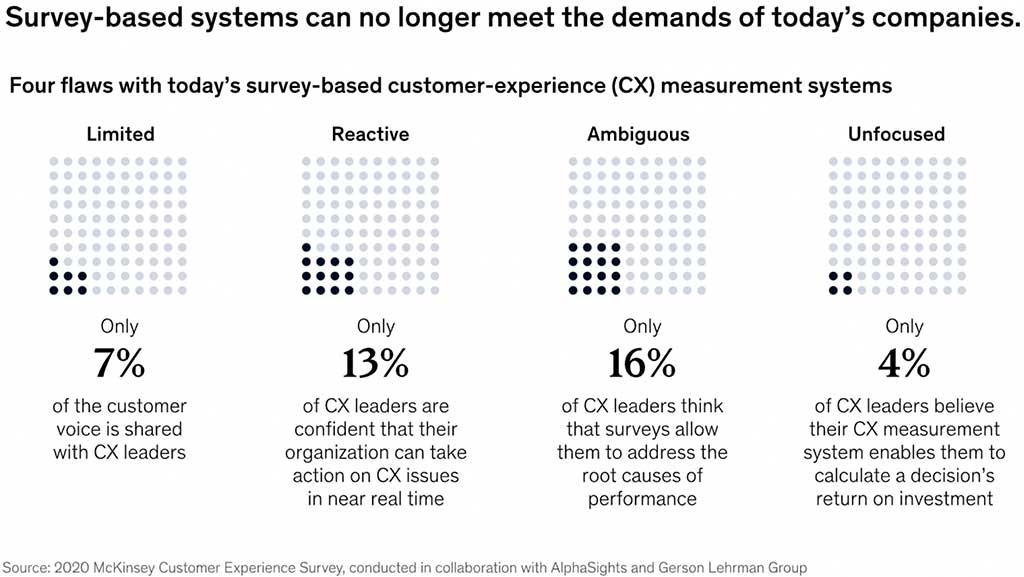Fundamentals
Why Customer Experience Research Is A Smart Business Investment

Written by: Phil Hesketh
Published on: Last updated:
Creating exceptional customer experiences has become a key differentiator for many companies trying to compete in crowded markets.
But how do you know what your customers really need and want—and how can you ensure they get it?
Read on to learn about the fundamentals behind customer experience research, why it’s so important for your business, and the steps to get started.
What is consumer experience research?
Consumer experience research (also known as “customer experience research” or “CX”) is the process of discovering how customers perceive your brand, product, or service based on how they interact with it.
The customer experience encapsulates every touchpoint of a person’s journey with your organization. This includes things like:
The moment a person initially becomes aware of your business. For example, browsing your website or clicking on a LinkedIn advertisement
Conversations with your sales or support team
Being onboarded into a new SaaS product
Navigating your app
Making a purchase from your store
Subscriptions and billing
Emails
Post-purchase support and follow-ups
The more positive interactions a person has with your brand, the better their overall experience will be, and the more they will talk positively about your business with friends and family. Positive CX can create a valuable referral network of new customers.
But as a consumer yourself, you know that a bad customer experience does the exact opposite—and this can leave a long-lasting, negative impression.
Thankfully, the customer experience is a dynamic one. If you listen closely to your customers by way of research, you can find out exactly what needs to change to manage their journeys, meet their needs, and improve the things that matter to them.
Is CX the same as customer service?
While customer service and customer experience share the same end goals—to delight your customers—they’re not the same thing.
Customer service is part of the customer experience, but it only applies to the stage in the customer journey that requires relationship management.
On the other hand, customer experience covers the entire end-to-end journey between a consumer and your organization.
The benefits of undertaking customer experience research
Most companies understand that providing a great customer experience drives revenue for their business. But chasing high Net Promoter Scores (NPS) and five-star G2 reviews means nothing unless it can be tied directly to financial growth.
Having a great product or service is no longer enough to be a differentiator. Customers expect a multichannel experience that connects them at a personal level with organizations they choose to buy from, and in some instances, this buyer experience is just as important as what they’re shopping for.
This means companies need to figure out new ways to deliver superior value and meet customer expectations.
The many benefits of effective CX include:
Revenue growth
Increased
Improved brand reputation
Creating more brand advocates
Understanding evolving customer expectations and behaviors
Reducing costs
Ensuring that any changes a brand makes have their basis in CX research—not just internal assumptions on what the stakeholders think should be improved
Developing a CX mindset means that companies can understand more of what’s actually working when it comes to creating a better customer experience, and how to tie that to a financial and competitive advantage when they undertake research and implement what they’ve learned.
A recent McKinsey study showed that CX leaders delivered 3X higher returns to stakeholders than companies who didn’t invest in research. As customer spending slows down, and customer acquisition costs increase for both B2C and B2B businesses, it’s become even more important for companies to pay attention to the evolving needs and behaviors of their customers.
How is CX research conducted?
All effective customer research strategies require a roadmap. This ensures that your organization’s time and money are well spent and that you reach conclusions you can use to create positive changes for both your customers and your company.
So—how do you research customer experience in a way that’s actually useful to your organization?
Establish your goals and customer experience research methods
Your customers don’t think in terms of metrics, channels, or journey maps. They just want to solve their problems, and they’ve chosen your organization to help them.
It’s important that you place a firm focus on goals that will create tangible outcomes for your customers which will, in turn, lead to increased brand loyalty, retention, and a thriving customer base.
CX research and testing will affect your whole organization, so it needs buy-in from key stakeholders and executives to maximize positive outcomes.
For example, your goals might be to evaluate and improve on:
Customer satisfaction during your SaaS onboarding process
Customer effort when they use your shopping cart checkout
Customer churn rate after using your product
Customer loyalty at physical retail stores
Next, decide how you’re going to measure CX to enable you to reach your objectives and create hypotheses. The methods you choose will depend on your customer base, industry, and specific types of goals.
You’ll need to look at whether you want to focus on broader goals such as “how do we improve the overall experience for our customers” or whether you want to improve things on a more granular level like “why do so many customers have problems with our delivery service”
These are the some of the most commonly used CX research methods and metrics:
Customer Satisfaction Score (CSAT)
This measures your customer’s satisfaction with your company, product, or service on a scale which is typically 1-10, with 1 indicating they’re deeply dissatisfied, and 10 meaning that you’re doing everything right to make customers happy.
Net Promoter Score (NPS)
A widely used metric that is used to gauge customer satisfaction, enthusiasm, and brand loyalty in respect of your products and services.
It’s based around a simple survey question “On a scale from 0 to 10, how likely are you to recommend this product/company to a friend or colleague?”
The NPS metric helps companies improve on their service, support, and product to increase their brand loyalty and referral percentages. It can also be tracked and quantified over time, and used to predict business growth.
When your company’s NPS aggregate score is equal to, or higher than, your industry average, this is a solid indicator that you have a great relationship with your customers in relation to other companies in your market.
While this metric isn’t enough to improve your CX as a standalone measurement, it can help you set benchmarks to maintain and improve upon over time.
Customer Effort Score (CES)
Customer effort is one of the strongest factors at play in customer loyalty. Gartner’s CES score can be used to measure the ease or difficulty of customer experiences when dealing with your product or service. It allows you to see where you can reduce friction and effort to boost loyalty, prevent churn, and reduce customer acquisition costs.
Churn rate
This metric is an indicator of growth, and measures how well a company can retain its customers. A high churn rate indicates low customer retention, which means a company is losing revenue and may not be able to sustain healthy growth in the long term.
CX research isn’t a once-and-done solution, and it shouldn’t be thought of in terms of numbers and percentages. It’s part of your ongoing strategy to deliver delight for your customers and benefits for your business growth.
You’ll need to map your goals and metrics to key growth goals, and prioritize your CX improvements based on which goals will ensure a faster, more customer-centric experience, while showing continued improvement for your organization.
Pinpoint the most important customer journeys
Once you’ve got your goals and metrics planned out, you can use them to identify, analyze, and prioritize your most important and valuable customer journeys.
Your teams can’t improve “everything” about the customer experience at once, so it’s important to break the “everything” down into steps that can be worked on in order of importance to reach your goals.
For example, if you know there’s a broader problem with customer onboarding in your software, you would start by mapping out the individual steps that people take during their onboarding journey. The more specific you can be when you’re looking at these journeys, the more accurate your diagnosis and solutions for improvement will be.
Your internal teams will have valuable insights on each specific customer journey so you can take feedback from them about what the problems are, and where possible improvements could be made.
You can always adjust these journeys later on, but it’s essential to have a starting point that will help you immediately improve the most “sticky” parts of your customer journeys and begin working on creating a higher quality, lower effort experience for people that buy from you.
Once you have professionally-created journey maps (or better, task analyses), which is the most valuable? That depends how you define value. How would your users and customers define value? Their definitions might be very different from definitions that revolve around “what does the business want to achieve.”
We want to be value-led. We want to consistently create high value and quality so that we attract new customers, make them happy, and make it easy for them to stay.
A good place to start when considering which customer journey is the most “valuable” is look at where the customer runs into problems and where the company is burning or losing money. We might be spending a lot on Customer Service tickets that could be self-serve. We might be leaving money on the table because our system is poor, and people need help. We might be losing sales.
Any opportunity to improve something for both the business and the customers is a prime candidate for creating value
Debbie Levitt, CX Consultant & Strategist, Delta CX
Create accurate customer journey maps
With your most important customer journeys planned out and signed off, you’ll need to create accurate maps of each journey, and identify the areas for improvement that reflect the end outcomes you want to see.
This means eliminating all the guesswork around each customer journey, and getting informed consent to collect real time feedback from your customers based on qualitative research methods like surveys and interviews.
You can also gather useful feedback with observed behavioral data and more indirect feedback loops—depending on your product or service, and where you suspect the problematic parts of the CX journey are. This might include things like product walkthroughs, heat mapping, social listening, CRM data, chat logs, customer support notes, and feedback from your sales team.
Doing the groundwork with responsible customer data collection and management will let your organization walk in your customers’ shoes and understand exactly what and where their pain points are.
Relying on guesswork or the opinions of stakeholders isn’t enough to ensure impactful customer experience improvements, and in many cases this could send you in the completely wrong direction.
But with accurate customer journey maps, you can visualize and connect all the touchpoints in every journey to see where the friction is, where people get stuck or drop out, and what can be done to improve their experience.
Read more: Recording and Managing Informed Consent
Create an action plan to measure the customer experience
Based on the insights you gain from talking to customers, analyzing feedback, and tracking the CX metrics you set out for each goal—you’ll need to create an action plan to:
Create a baseline for your measurements
Collect ongoing feedback and sentiments
Track progress over time
A quantitative measuring system should be set up that can be mapped back to your initial CX metrics as you apply and test what you’ve learned as you work on ironing out the friction in your customer journey maps.
Regularly checking in on metrics like NPS and CSAT can help you monitor changes and improvements so you can see how effective your CX initiatives are over time.
By tracking and measuring changes in customer behavior and sentiment at each touchpoint of a customer journey, you can build out models and reports that can be shared with stakeholders to prove that your CX studies are driving a positive change.
With accurate tracking and reporting, you can more easily share quick wins and custom insights, and secure buy-in and funding for future research.
Test and iterate what you’re learning
Improvement is an ongoing process. Armed with your ongoing CX feedback, you need to go forth and apply what you’ve learned in a data-driven way to create a more seamless, customer-centric experience that shapes your buyers’ decision-making journeys.
Your research might lead you to test and iterate on:
Automations
Unified commerce solutions
Increased personalization
Simplified checkout flows
Faster page loading times
New products and services
No matter how you act on the feedback you get, your customers always need to be at the heart of your decision-making—over and above driving growth for your business. If you have that first step in place, the rest will follow.
Image Source: McKinsey & Company
It’s also essential to let customers know that you’ve listened to their needs and are making changes.
By actively including customers in your research feedback loops, it makes them more likely to provide feedback in the future—as they can see your organization has taken their concerns seriously and has taken action to improve things.
The future of CX research
Since the onset of the pandemic, customer needs have evolved. An increasing amount of B2B customers say they would like a customer experience that’s more like those provided by B2C brands.
Consumers also want a more personalized experience from organizations. A recent study found that companies who personalize generate 40% more revenue than those who don’t.
A 2021 McKinsey study on the future of customer experience research shows that there is an increasing need for CX leaders to approach their goals and objectives in new ways to keep up with customer expectations and demand.

Traditional methods of CX like surveys and interviews are gradually being moved aside in favor of more complex and comprehensive technology that can measure, aggregate, and analyze huge amounts of data across in-person and digital channels—allowing companies to test and iterate their findings at speed.
With technology and AI in the mix, organizations can quickly gather data sets around how customers interact. Their profiles, purchases, and sentiments can then be used to more accurately predict (and improve on) customer behaviors.
As data-driven CX technology evolves, there is a huge opportunity for your company to get better at understanding your customers wants and needs at a granular level.
Companies that embrace this evolving CX technology will have a superior advantage over their competitors who are still relying on older methods of customer experience research.
Wrapping up
With increasing competition across all industries, customer experience research is becoming a necessary investment for companies who want to maintain a competitive advantage and grow their brand.
If you’re looking to carry out CX research for your company, Consent Kit can help you formalize your research process, save time, and ensure your studies are accessible, compliant, and efficient. Try it free for 14 days.



